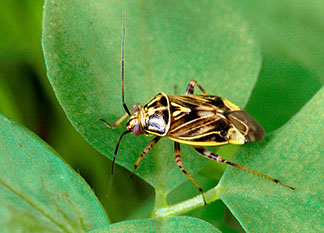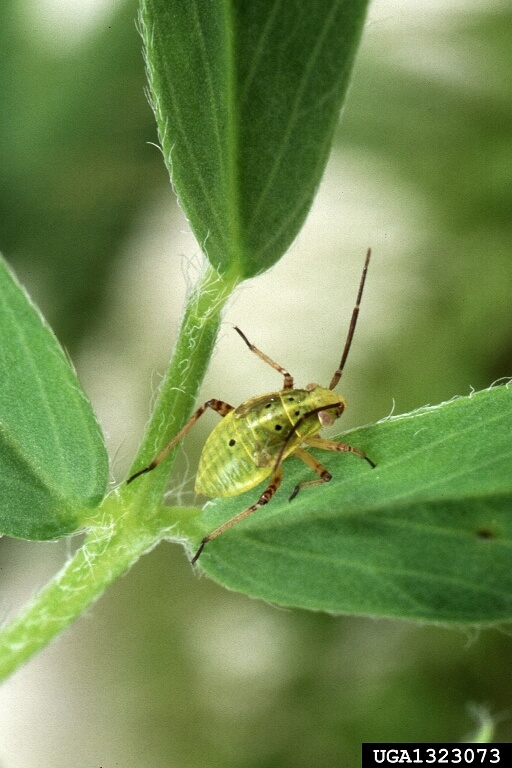Tarnished Plant Bug (Lygus Bug)
Lygus lineolaris
|
Tarnished plant bug adult. |
Tarnished plant bug nymph |
Adult lygus bugs are less than 1/4 inch long and mottled brownish with a small triangle in the center of their back. Nymphs are green and have a series of 5 black spots on their back. Most damage to canola is associated with feeding by late instar nymphs (4th and 5th instars). Lygus bugs have piercing, sucking mouthparts and feeding on flower buds will cause flower abortion, whereas feeding on developing pods and seeds will reduce seed quality and oil content and may also facilitate the development of pod diseases. Drought stress will make the crop less able to compensate for flower losses that occur in early stages of bloom, so crop condition should always be considered when assessing damage potential.
Lygus bugs have a wide host range and can build their numbers in many different crops where they may not be considered serious pests, and then move to other crops where they cause economic losses. They can also increase their numbers on various weeds such as Russian thistle, kochia, pigweed, wild mustards, and lamb's quarters. In Kansas, there can be 3-4 generations per year, and alfalfa can be an important source of lygus bugs that migrate into other crops in large numbers when the hay is cut.
Scouting for lygus bugs should be done by sweep netting during fair weather conditions (sunny and warm, low winds), beginning when the crop is bolting, and ending as pods harden and approach maturity. Keep in mind there will always be some lygus bugs present, but often not in numbers that require treatment. The economic threshold ranges from 20-30 lygus nymphs per 10 sweeps, based on 5 samples from different parts of the field. Only late instar nymphs (those with 5 black spots and developing wing pads visible on their backs) and adults should be counted, as smaller instars do little damage and suffer high levels of natural mortality. The lower threshold should be used for stands in poor condition with less ability to compensate for damage. Applications made in early flowering stages may not control later-emerging nymphs, as eggs are embedded in plant tissues, but application at 90% bloom is usually effective in preventing most yield losses.
Please refer to the most recent Canola Insect Management Guide for a list of insecticides registered for control of diamondback moth.
Page last updated by J.P. Michaud, 5/2/2024.

